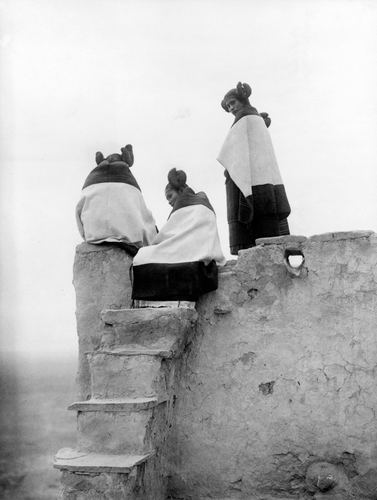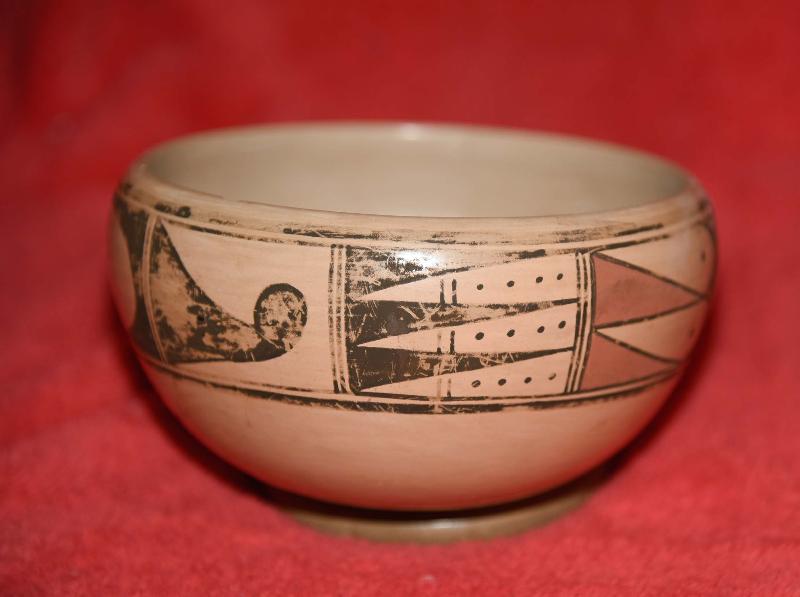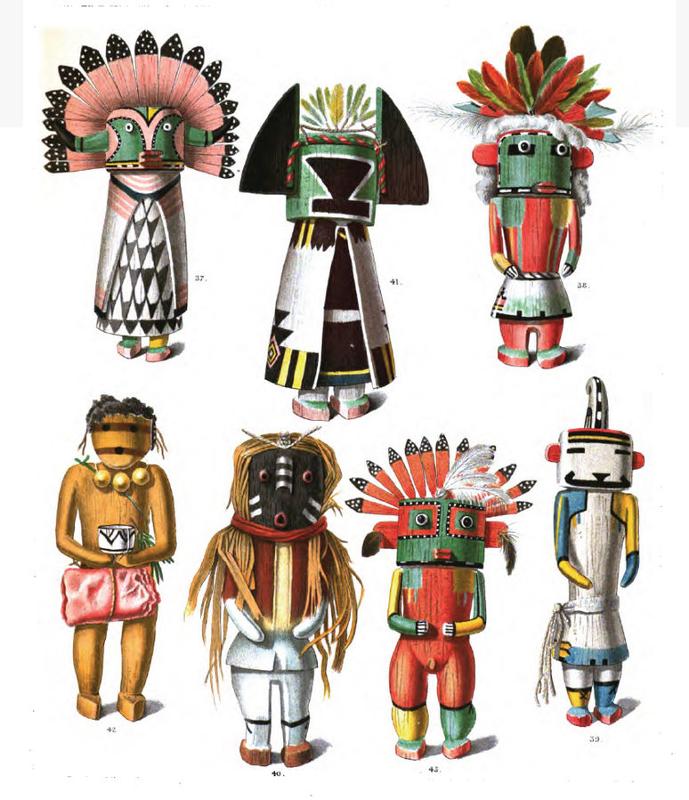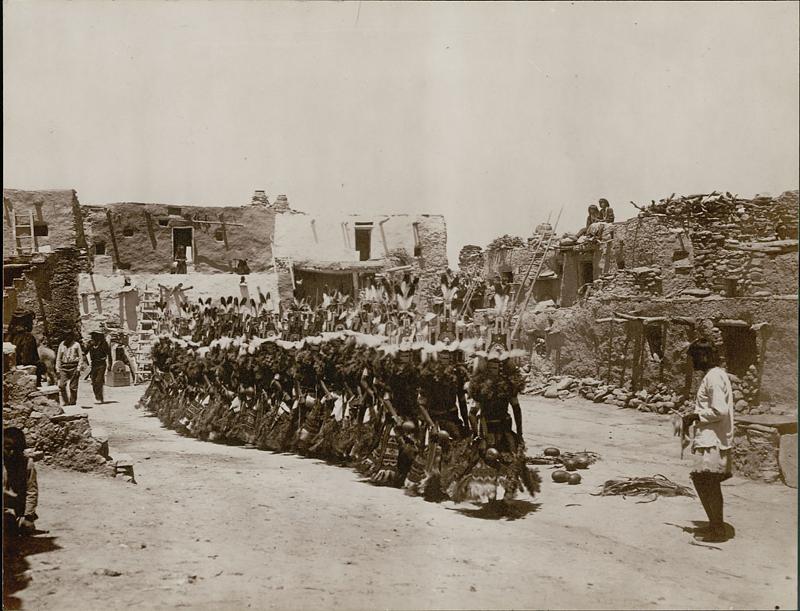
The Hopi
Module 4
The Hopi are Pueblo Indians who live on and adjacent to three mesas in the northwestern corner of Arizona. Their relatively small reservation is surrounded on all sides by the much larger Navajo reservation. Because of their relative isolation and the harshness of the environment, the Hopi people have been less impacted by European contact than have some other tribes. Like their ancestors, the modern-day Hopi are farmers and craftspersons who follow a complex ceremonial cycle to ensure the well being of the world.

Griffin-Pierce Chapter 3 (textbook)
Watch this film clip - Hopi; Songs of the Fourth World. This is a 59 minute video.
|
Piki bread making
|
|
Hopi-Navajo land dispute
|
|
Peabody-Coal Mine dispute - https://orionmagazine.org/article/the-black-mesa-syndrome/
http://www.huffingtonpost.com/2013/06/06/coal-mining-navajo-nation_n_3397118.html
|
Click on next page to continue.
SummaryThe Hopi Indians live in northeastern Arizona, in towns spread out on and below three different mesas. Like other Pueblo Indians, they are farmers who lived in large towns at the time of European contact. Today, there are twelve villages on the Hopi reservation, all except one of which are populated by Hopi people. The exception is Hano, a village settled by Tewa Indians from the Rio Grande Valley in the late 17th century. Today, the villagers of Hano are known as the Hopi-Tewa. Ancestors of the Hopi (called Hisatsinom by the Hopi) have lived in this region since at least the time of Christ, and one of the towns- Old Oraibi- has been continuously occupied since about A.D. 1100.
Walpi village, located on First Mesa in Hopi. The original village of Walpi was established at about 900 A.D., but fearing reprisals, the villagers moved to the top of the mesa after the Pueblo Revolt in 1680. This village has been occupied continuously since that time, though today few if any families live there year-round. Source - http://sirismm.si.edu/naa/baegn/gn_01827.jpg
|
Click on next page to continue.

The Hopi speak a branch of Uto-Aztecan, which is a large family of languages extending from the northern Great Basin to central Mexico. Their closest linguistic relatives are the Numic speakers of the Great Basin.
Click on next page to continue.
The Hopi are expert farmers in an area that might not, at first glance, appear to be conducive to farming.The Hopi homeland lacks permanent rivers or lakes and has limited rainfall. Winters are cold and the growing season is short.To successfully farm in this area, the Hopi developed special strains of corn that could withstand the short growing season and limited moisture. Hopi corn has long tap roots, designed to reach deep to where the moisture is, and short stalks, designed to withstand the strong winds that can blow across the mesas. The corn is planted in widely spaced intervals in sand dunes, which tend to hold more moisture than other areas. In addition to this sand dune farming, the Hopi also practice floodwater farming (where fields are watered by overflow from the banks of rivers) and ak chin farming. Ak chin farming consists of farming at the mouths of arroyos, or washes, to catch the water that spreads out on alluvial fans after rains. Each family typically maintains several small fields in a variety of locations, in order to maximize the likelihood that at least one field of crops will survive.

Ak chin corn field plants in sand dunes
Click on next page to continue.
The prehistoric ancestors of the Hopi are known for their yellow ware pottery. This type of pottery, which began to be produced at about A.D. 1300 and continues to be produced today, was fired using coal that the ancestral Hopi mined from below the mesa tops. (The Hopi Indians are the only Native Americans to have used coal in prehistoric times; see textbook for more discussion).

At about this same time, as also see piki stones in the archaeological record, used then (as today) to make piki bread. Piki is a wafer thin "bread" made from a thin corn meal; it is cooked on griddles known as piki stones. Today, the Hopi are known for their basketry, pottery, jewelry making, and kachina dolls. Traditionally, kachina dolls (known as tihu or tithu to the Hopi) were given to Hopi girls, but beginning in the Great Depression the Hopi began to sell them to tourists for extra income. Today, the manufacture and sell of kachina dolls is a major source of income for the Hopi.

Drawing of kachina dolls, made in 1894
Click on next page to continue.
Until recently, the town was the largest sociopolitical unit (today, there is a Hopi Council makes certain decisions for all Hopi). Each town was endogamous, meaning that individuals were expected to marry others from their same town. Although each town had a chief, this was largely a ritual position and the chief had little secular decision-making authority. Instead, power among the Hopi was spread among a variety of chiefs, clan heads, and society heads.
The matrilineal clan was the primary decision-making unit. It was the clans that controlled the agricultural lands, and the clan leaders who made decisions about how these lands were to allocated. The clan leaders were also responsible for particular ceremonies and for maintaining the ceremonial paraphernalia associated with the ceremonies. The clans were ranked in terms of prestige, with the greatest prestige belonging to those clans that had lived in the village the longest. The clans, in turn, were grouped into larger entities known as phratries.
In addition to the clans and phratries, there were several men's societies that were responsible for certain social functions, including society initiations and hosting certain ceremonies and social dances. A society's membership would include individuals from several different clans; thus, they provided an important mechanism for integrating the town and helped prevent the concentration of power into any one clan or group. Among the Hopi, perhaps the most important society was (and still is) the kachina society, which is responsible for conducting the kachina dances to ensure rains come and to bring well being into the world. Kachinas are supernatural beings that bring prosperity and harmony to the world; the term is also used to refer to the masked figures that impersonate the kachinas in the dances as well as the carved wooden dolls that represent these beings.

Kachina dance, 1901
Source - SPC Sw Hopi No # Ceremonies 01595300, National Anthropological Archives, Smithsonian Institution
Thus, among the Hopi, power was distributed among a variety of chiefs, society heads, and clan heads. There was a hereditary aspect to this power, in that some clans held more power and prestige than other clans. However, this did not translate into greater wealth or into a concentration of secular power. This social organization gave the Hopi great flexibility and provided long-term stability to the system. However, in historic times, it has created difficulties for the Bureau of Indian Affairs (BIA) and U.S. governmental officials used to dealing with more centralized governments. Secular governors and tribal councils installed by U.S. officials have met with mixed reception among the Hopi, who are not used delegating authority to one individual or council.
Click on next page to continue.
Like other Puebloan groups, the Hopi believe that their ancestors came to the earth from the underworld. Once arriving in this fourth, or outer, world, the people dispersed over the earth in a series of migrations. After death, individuals will return to this underworld, emerging as kachina spirits during the summer to bring the rains so needed for the crops. Hopi ideology emphasizes unity and cooperation; aggressive behavior is frowned upon. Gossip and gentle belittling by the clowns who perform at kachina ceremonies are the primary forms of social control.
|
Five koshare clowns performing at the Hopi-Tewa village of Hano, ca. 1891 |
1899 drawing of a Koshari clown in striped body paint and cap with horns |
|
Source - BAE GN 01820K1 06312201, National Anthropological Archives, Smithsonian Institution
|
Source - Local number NAA INV 08547446; Manuscript 4731, National Anthropological Archives, Smithsonian Institution |
Hopi ceremonies follow an annual, calendrical cycle consisting of two major periods. The first cycle, beginning in January or February and continuing until July, marks the period when the kachina spirits are present in the villages. Ceremonies during this period are focused on the kachina dances, when men where masks to impersonate the kachinas. This cycle ends with the Niman dances, which coincide with the end of planting in the fields and with the return of the Kachina to their spirit homes. The remainder of the ceremonial year is devoted to non-masked social dances.
Click on next page to continue.
|
Today, the Hopi continue to live on the same mesas as they did when the Europeans arrived. In many ways, their lives are similar to those of their ancestors— there continues to be an emphasis on farming, kachina ceremonies, and an ideology that focuses on community and cooperation. The Hopi people continue to make pottery and baskets, as did their ancestors, though today these are made largely for the tourist market.
However, they also face several issues not faced by their ancestors. Strip mining by the Peabody Coal Company has caused the water table to drop substantially, a consequence which threatens farming on the mesas. Currently, this issue is again in the news as the Peabody Coal Company is proposing to renew its operations.
The Navajo Generating Station, which provides electrical power to customers in Arizona, Nevada, and California, relies on coal obtained from Black Mesa for its fuel source Source - Shutterstock Image ID: 243713995 |
Additionally, the Hopi have been involved in an ongoing land dispute with the Navajo (watch the video below)
The Hopi reservation is completely surrounded by the much larger Navajo reservation.
|
Click on next page to continue.
Practice Quiz # 3